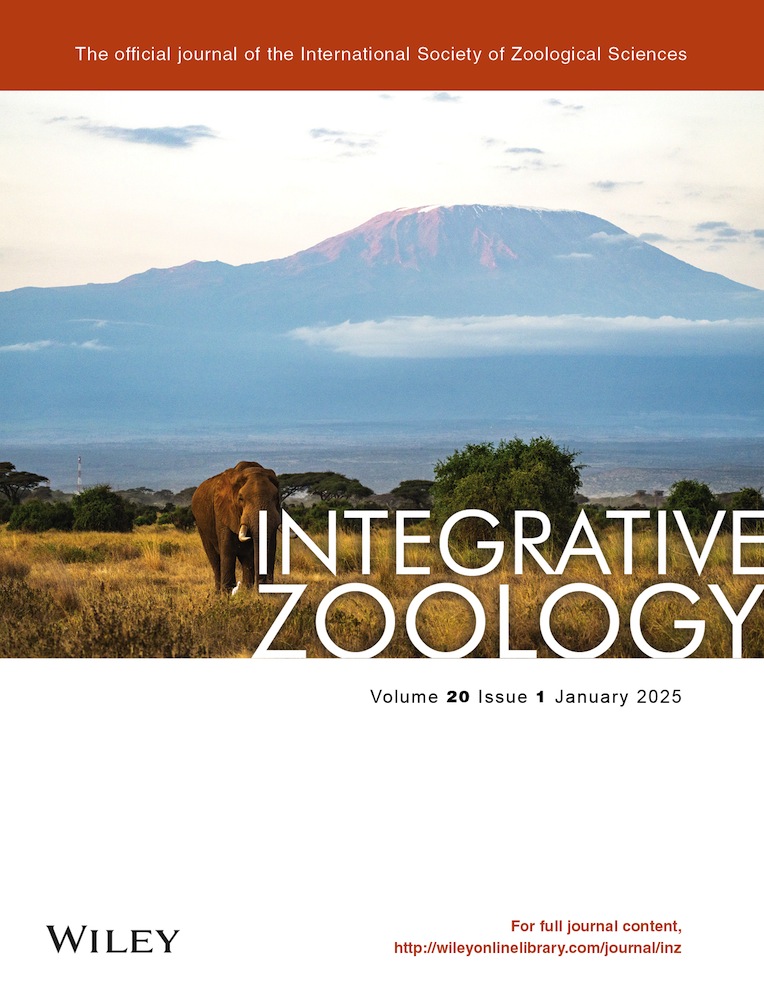A newly discovered Hystrix primigenia specimen from the Kemiklitepe collection at Ege University Natural History Museum: insights into paleobiogeography in Eurasia
Abstract
Porcupines, members of the Hystricidae family, represent a unique group of herbivorous mammals. This study details the identification of a newly discovered mandible fragment of Hystrix primigenia, along with a right cheek tooth series from the middle Turolian Kemiklitepe-A fossil locality. While Hystrix fossils are found in numerous localities, the materials are often limited to a few dental fragments or isolated teeth, posing challenges to systematic investigations. The examination of this lower tooth series prompted a comprehensive review of all H. primigenia findings across Eurasia, shedding light on its adaptive characteristics over time and space. Our paleobiogeographical analysis indicates the absence of H. depereti in Late Miocene Türkiye, while the dispersal range of H. primigenia is broader than that of H. depereti in Eurasia. Additionally, the study delves into the discussion of H. primigenia and H. depereti findings in Eurasia, ultimately refining the categorization of Late Miocene Hystrix discoveries in Türkiye to two species: H. primigenia and H. kayae. Our review suggests the possibility of an additional H. kayae finding from Samos, Greece.
INTRODUCTION
Porcupines (Hystricidae) constitute a distinctive and specialized family primarily composed of thorny and herbivore mammals. Extant porcupines are frequently targeted by medium and large predators such as lions, panthers, hyenas, wolves, and foxes (Mori et al. 2014; Viviano et al. 2020). These aposematic animals are well-known for their scavenging diet, both in extant and the fossil record (Uldis 2012; Wieckowski et al. 2013, Mori et al. 2014; Coppola et al. 2020). Old World porcupines are classified within the family Hystricidae, comprising three distinct genera: namely Trichys and Atherurus, which belong to the subfamily Atherurinae, and Hystrix, which belongs to the subfamily Hystricinae (Happold 2013). The genus Hystrix comprises eight species, exhibiting the most diverse geographical distribution and is further categorized into three subgenera (Corbet & Jones 1965; Happold 2013): Acanthion, found in South and Southeast Asia; Thecurus, endemic to Southeast Asia; and Hystrix, with the widest geographical distribution from Africa to Eurasia (Amori et al. 2008; Şen & Purabrishemi 2010; Azzara et al. 2022). Although its fossil records are limited in many localities, this adaptable and widely distributed genus likely inhabited similar geography from the Late Miocene to recent times (Wang & Qiu 2002; Van Weers & Rook 2003; Şen & Purabrishemi 2010; Nishioka et al. 2011, 2020; Azzara et al. 2022). This conclusion is drawn from fossils attributed to Hystrix discovered in various Eurasian and African localities, dating as far back as the early Turolian and persisting until the Quaternary.
The earliest occurrence of the genus Hystrix is represented by Hystrix parvae (Kretzoi 1951) from Salmendingen (Germany) (MN9–11, NOW; MN6–17, Halaçlar et al. 2024), Kohfidisch (Austria) (MN6–11, NOW), and MN11 localities of Csakvar (Hungary) and Crevillente 2 (Spain) (Van Weers & Montoya 1996; Şen 2001a; Van Weers 2005; NOW 2023). Recent research by Halaçlar et al. (2024) has led to some uncertainty regarding the earliest findings of Hystrix. The study reports the discovery of a new Hystrix species, named H. kayae, and suggests that H. parvae and H. kayae are coeval, challenging previous assumptions about the earliest occurrence of the genus.
Three Hystrix species have been documented across seven localities from Late Miocene Anatolia (Fig. 1) (Atalay 1980; Ünay & Bruijn 1984; Şen 1994; Van Weers& Rook 2003; Pietro 2013; Halaçlar et al. 2024). The oldest among them, H. kayae, was identified in the Çorakyerler locality (Early Turolian, MN11). H. primigenia has been recorded in four Anatolian localities namely Bayırköy, Şerefköy, Kemiklitepe, and Gülpınar (Van Weers & Rook 2003; Halaçlar et al. 2024). The youngest species, H. depereti, was documented in Çobanpınar (MN13) (Van Weers & Rook 2003). Prieto (2013) reported an upper molar from Taşkınpaşa (MN11–13), designating the specimen as Hystrix sp. While H. primigenia is relatively common in Europe (Van Weers & Rook 2003; Şen & Purabrishemi 2010; NOW 2023), it appears to be absent from Asia (excluding Anatolia). H. primigenia is recorded in 30 Pliocene–Miocene localities in Eurasia (see Table S1, Supporting Information). The oldest record is in Kemiklitepe A-B, while the youngest occurrences are in Kvabebi, Georgia and Raciszyn 1, Poland (Van Weers & Rook 2003; Şen & Purabrishemi 2010; Fejfar & Sabol 2022; NOW 2023). Şen (2001b) re-described Perpignan porcupines and reallocated them to a new Hystrix species, named H. depereti. Subsequently, Van Wears and Rook (2003) provide a review of Turolian porcupines, reallocating certain H. primigenia findings to H. depereti based on size and enamel height. This study will further discuss these reallocations.
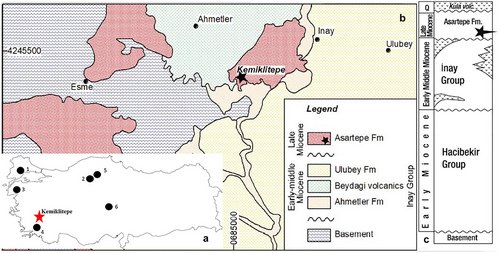
Şen (1994) conducted the initial study on Kemiklitepe Hystrix, describing two upper series and a mandibular fragment that included p4 and incisor fragments. In this study, we present the analysis of a mandible fragment discovered in the Late Miocene of Kemiklitepe-A, Türkiye. These fragments constitute the first lower cheek teeth series of H. primigenia from Kemiklitepe. The identification of this fossil enhances our ability to compare the Kemiklitepe-A specimen with those from various locations.
Locality
The initial exploration of fossils at Kemiklitepe was conducted by Yalçınlar (1946). Subsequent studies of the fauna were carried out by Ozansoy (1957, 1969), Becker-Platen et al. (1975), Tuna (1985), and Şen et al. (1994). The study by Şen et al. (1994) was part of an extensive monograph on the stratigraphy and paleoecology of the site, providing a detailed description of the new mammal collection. They established an estimated age of approximately 7.7–7.1 Ma for the fossil-bearing formation, based on magnetostratigraphic correlation. This estimation was further corroborated by the presence of the typically Turolian fossil mammal assemblage.
Recent field investigations conducted by Seyitoğlu et al. (2009) and Karaoğlu et al. (2010) have determined that the fossiliferous sediments are part of the Asartepe Formation and are situated atop the Ulubey Formation, as depicted in Fig. 1. The Asartepe Formation is primarily composed of massive mudstones with fine-grained conglomerate alternations supported by a matrix, indicative of subaerial deposition in a distal alluvial fan environment. The conglomerates contain pebbles to boulders derived from the underlying metamorphic basement rocks of the lacustrine Ulubey Formation and the volcanic Beydağı Formation, as reported by Seyitoğlu et al. (2009).
Based on the findings of Seyitoğlu et al. (2009), it is evident that the fossiliferous sediments within the Asartepe Formation were deposited after a period of erosion. This conclusion is supported by the examination of the valley floor and the contact zone between the Ulubey Formation and the Asartepe Formation and aligns with the findings of Ercan et al. (1978) and Seyitoğlu et al. (2009).
The previously identified fossiliferous horizons at Kemiklitepe comprise the upper and younger sites Kemiklitepe-A (KTA), Kemiklitepe-B (KTB), and Kemiklitepe-C (KTC), along with the lower stratigraphic level of Kemiklitepe-D (KTD), as documented by Şen et al. (1994). These two layers are vertically separated by a distance of 15 m. Faunal and magnetostratigraphic correlations point to a woodland/forest environment, with an estimated age of approximately 7.1 Ma for KTA, KTB, and KTC, and about 7.6 Ma for KTD, according to Şen et al. (1994). In a recent study, a new locality was identified in Kemiklitepe, situated 350 m northwest of the classic Kemiklitepe localities (Xafis et al. 2021). The new locality, named Kemiklitepe-E (KTE), is positioned at the same stratigraphic level as the KTA–C localities (Xafis et al. 2021).
If there is no specific citation, given ages in brackets are sourced from the Neogene Old World database (NOW).
MATERIALS AND METHODS
The dental terminology utilized in this study adheres to the conventions established by Van Weers (1990), Şen (2001a), Lopatin et al. (2003), Van Weers and Rook (2003), and Azzara et al. (2022), Halaçlar et al. (2024) (Fig. 2). Azzara et al. (2022) present a comprehensive list of these terms in their literature, serving as the primary reference for this study (Azzara et al. 2022, online resource 2). Specifically, the term “system of wear classes,” was developed by Van Weers (1990) and Van Weers and Rook (2003) to classify the stages of tooth wear. Left-side teeth are consistently designated as such in all visual representations, and reversed specimens are indicated by underlining the corresponding figures. All measurements were taken using an electronic caliper with a precision of 0.01 mm. The diagrams are generated using PAST 4.03 (Hammer et al. 2001)
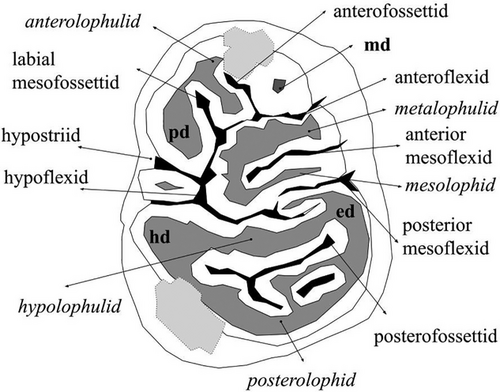
Institutional abbreviations: EUNHM, Ege University Natural History Museum, Izmir; MNHN, Muséum national d'Histoire naturelle, Paris; UEKT = UEK = KT, Uşak, Esme, Kemiklitepe; PV, Paleontology Vertebrate; IPGM: Institut für Paläontologie und Historische Geologie, München; TSPI: Taganrog State Pedagogical Institute in Taganrog, Russia.
Terminologies: EH, the enamel height measured on the lingual side; EH/L, enamel height/length; L, length corresponding to the maximum values along the longitudinal tooth axe situated in the middle crown height; W, width corresponding to the maximum values along the transverse tooth axe in the middle crown height.
SYSTEMATIC PALEONTOLOGY
Order Rodentia Bowdich, 1821
Family Hystricidae Fischer, 1817
Genus Hystrix Linnaeus, 1758
Type species: Hystrix cristata Linnaeus, 1758.

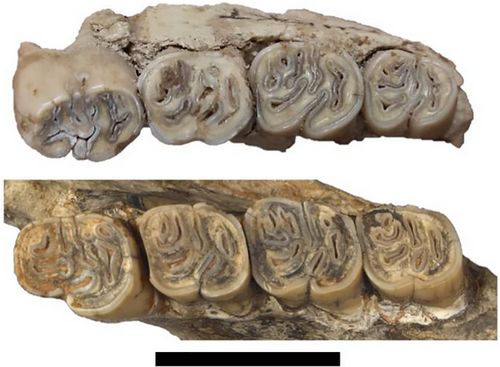
Holotype
Left lower incisor fragment, IPGM ASII 146.
Type locality
Pikermi, Greece.
Geographical occurrence
Eurasia and North Africa.
Chronological occurrence
Late Miocene to Early Pliocene.
Referred material
PV-UEKT-A 88, left mandibular fragment with the left p4–m3, collection of the EUNHM. The mandibular bone is primarily preserved on the cheek teeth root.
Locality
Kemiklitepe, Eşme/Uşak, Türkiye.
Aged
Late Miocene, MN12 Mammal Neogene Zone.
Measurements
See Table 1.
| Kemiklitepe | Pikermi | Bayırköy | Gülpınar | Şerefköy | Perpignan | ||
|---|---|---|---|---|---|---|---|
| H. primigenia | H. depereti | ||||||
| p4 | L | 12.68 | 11.2 (4); 11–11.3 | 10.7 | 11.5 | 11.2 | 12.9 (5); 12.3–13.2 |
| W | 10.32 | 9.9; 9.6–10.3 | 9.2 | 9.8 | 10 | 11; 10–11.8 | |
| EH (E/L) | 9.46 (0.74) | 0.7; 0.41–0.95 | (0.64) | (0.92) | (0.35) | 0.89; 0.71–1.6 | |
| m1 (m1/2) | L | 11.59 | 10.3 (9); 9–11.6 | 8.8–9.3 | 10.1–11.2 | 8.8–11.1 | 11.7 (10); 11.1–13.2 |
| W | 9.81 | 8.8 (9); 8.4–9.4 | 8.2–8.3 | 9–9.8 | 9.0–10.0 | 11; 10–11.8 | |
| EH (E/L) | 4.7 (0.4) | 0.54 (7); 0.39–0.72 | (0.5–0.63) | (0.55–0.59) | (0.23–0.28) | 0.78; 0.53–1.1 | |
| m2 | L | 11.77 | |||||
| W | 9.95 | ||||||
| EH (E/L) | 6.67 (0.67) | ||||||
| m3 | L | 10.32 | 9.7 (3); 9.4–9.8 | 9.6 | 10.4 | 10 (5); 9.6–10.5 | |
| W | 8.7 | 8.6; 8.4–9.4 | 7.6 | 9.9 | 8.7 (5); 8.4–9 | ||
| EH (E/L) | 8.21 (0.8) | 0.54; 0.39–0.72 | (0.5) | (0.29) | 0.82 (4); 0.55–1.01 | ||
| p4–m3 | 45.54 | 41.6 (3); 39.4–43.4 | 39.8 | 41.2 | 47.5 | ||
Description
The teeth are well-preserved in the left hemimandible fragment PV-UEKT-A 88 (Figs 3, 4, Supporting Information 2), while the mandibular bone is preserved primarily around the roots. Four roots of p4 are visible, and three of them are damaged. In the occlusal view, the lower cheek teeth exhibit a labial twist from posterior to anterior (i.e. the occlusal face of m3 bends lingually while p4 bends labially). In the lateral view, the connection line between the mandibular bone and teeth rises anteroposteriorly resulting in higher p4 hypsodonty than in molars. The anterior part of the molars is significantly larger than the posterior, while p4 displays the opposite pattern. The occlusal surface of p4 corresponds to wear class O3. The condition of m3 (S1) suggests that the Kemiklitepe specimen belongs to age class V, according to Van Weers's (1990) classification. This information indicates that the Kemiklitepe specimen represents a subadult individual.

The occlusal surface of p4 exhibits a water drop shape from anterior to posterior, with all cusps fully erupted. In the occlusal view, the hypoflexid is narrow and aligned parallel to the main axis of the p4. The hypostriid crosses vertically on the labial wall of the crown, terminating 4.65 mm above the root line. Four lingual folds are visible in the occlusal view. The anterofossettid separates the metaconid from the anterolophulid and is connected to both the anteroflexid and the hypoflexid. The anteroflexid labiolingually reaches to hypoflexid and throughout this stretch and it connects with the anterofossettid and the labial mesofossettid. The anterior mesoflexid opens on the lingual side and closes on the labial side due to the connection between the metalophulid and mesolophid. The metalophulid and mesolophid are connected, forming a “U” shape lingually. The labial mesofossettid nearly reaches the mesial border of the tooth, separating the protoconid from the anterolophulid. The posterior mesoflexid reaches the hypoflexid, dividing the occlusal surface of p4 into two parts. Lingually, the posterior mesostriid and anterior mesostriid are visible, while the anterostriid is not well visible. The posterofossettid does not open on the border of the tooth and forms two enamel islets in the posterolophid. A robust labiolingual connection between the hypoconid and entoconid is established via the hypolophulid. Distally, a similar connection between the hypoconid and entoconid is formed by the posterolophid in a “U” shape. Between the protoconid and hypoconid, a small additional/accessory closed lophulid is present, restricted by the hypoflexid and labial mesofossettid. The less worn metaconid is not as prominent as the protoconid.
The occlusal surfaces of m1 and m2 are rectangular while the m3 is trapezoidal. In the occlusal view of the molar series, the anterolingual corner is more robust and less unworn than other corners.
The m1 has the lowest enamel height (EH) among the lower cheek teeth and is slightly smaller than m2 (Figs 3, 4, and Table 1). The tooth is worn nearly to the hypostriid, with the hypostriid crossing vertically on the labial wall of the crown and terminating 4.28 mm above the root line. The hypoflexid has transformed into an islet, contributing to the seven enamel islets on the occlusal surface of the m1. The posterofossettid retains a narrow ellipse shape. There is no connection between the posterior mesoflexid and hypoflexid, and they both form islets. The labial mesofossettid is anterolingually concave. The anterofossettid consists of two islets, and the anterior mesoflexid runs labiolingually, unable to reach the labial mesofossettid. In the anterior part, the metaconid is considerably stronger than the protoconid, while in the posterior part, the hypoconid is stronger than the entoconid.
Apart from differences in size and configuration of the posterior mesoflexid and hypoflexid, the occlusal outline and pattern of m2 closely resemble those of m1. While the posterior mesoflexid and hypoflexid in m2 are not islets and instead fold, the posterior mesoflexid aligns linguolabially, while the hypoflexid aligns posterolingually. The labial mesofossettid and posterofossettid of m2 exhibit slightly more prominent than m1. The hypostriid in m1 and m2 terminates 4.45 and 4.33 mm above the root line, respectively.
The occlusal outline and size of m3 differ slightly from the other molars, although the occlusal outline itself is similar. A notable distinction in the occlusal pattern lies in the connection between anterofossettid and anterior mesoflexid. The anterior part is twice the size of the posterior part, resulting in m3 adopting a teardrop shape. The hypostriid terminates 3.98 mm above the root line.
COMPARISONS AND DISCUSSIONS
Distinguishing characteristics of Hystrix species in various studies include the occlusal pattern, occlusal outline, enamel height, and cheek teeth size. (Van Weers 1990; Şen 2001a,b; Lopatin et al. 2003; Van Weers & Rook 2003; Şen & Purabrishemi 2010; Flynn & Wu 2017; Fejfar & Sabol 2022; Azzarà et al. 2022; Halaçlar et al. 2024). Although the occlusal pattern of Hystrix species generally exhibits a degree of conservatism, it remains an informative feature. In systematic studies, the occlusal outline frequently serves as a pivotal criterion, with size being the primary discriminant for taxa differentiation (Van Weers & Rook 2003; Şen & Purabrishemi 2010; Fejfar & Sabol 2022; Halaçlar et al. 2024). Şen (2001a) and Van Weers and Rook (2003) have noted a significant transition in hypsodonty among Hystrix species during the middle Turolian period. Notably, later Miocene species exhibit a heightened degree of hypsodonty, as exemplified by H. depereti in the latest Miocene.
In this part, we will perform a comparison using these four key characters: the occlusal pattern, occlusal outline, enamel height, and cheek teeth size. Considering the age of Kemiklitepe, we primarily focus on the middle Turolian Anatolian porcupines, specifically H. primigenia and H. depereti. However, initially, we will exclude other Eurasian porcupines from our analysis.
The oldest Hystrix species are H. kayae and H. parvae. H. parvae, being a small porcupine, can be readily distinguished from the Kemiklitepe specimen by its size and occlusal pattern (Fig. 3 and Table 1; Van Weers & Montoya 1996, plate 1). Conversely, H. kayae shares a similar size with the Kemiklitepe sample, but it exhibits a wholly distinct occlusal outline and pattern (Şen 1999, fig. 1; Halaçlar et al. 2024, fig. 5). It is important to note that direct comparisons between the two are not feasible here, primarily due to the difference in sample composition—H. kayae consists of maxillary samples, whereas our sample is hemimandible. Similar to H. kayae, H. aryanensis shares a comparable size with the Kemiklitepe specimen and is primarily composed of maxillary samples. However, it is worth noting that its occlusal pattern and outline exhibit subtle distinctions when compared to the Kemiklitepe porcupine (Şen 1999, fig. 1; Halaçlar et al. 2024, fig. 5).
The Pikermi H. primigenia specimen displays a pattern of increased wear from m1 to m3, resulting in a decrease in EH (enamel height). In contrast, the Kemiklitepe specimen demonstrates the opposite trend, with EH decreasing from m3 to m1. The Pikermi specimen records its lowest EH at m3, whereas for the Kemiklitepe specimen, the lowest EH is observed at m1. In both the Kemiklitepe and Pikermi specimens, the lower cheek teeth exhibit linguolabial twisting from m3 to p4. Additionally, in both specimens, there is a slight reduction in size from m2 to m1, with m1 being slightly smaller than m2. Both specimens share similar occlusal outlines for all teeth, except for m3. In the Pikermi specimen, m3 exhibits a rectangular shape, whereas in the Kemiklitepe specimen, it takes on a teardrop shape. Although the occlusal pattern in m1 and m2 is notably similar, discernible differences become apparent in p4 and m3. It is important to consider that these distinctions can be attributed to wear levels and the intensity of occlusal pattern variations. According to Şen (1994), the upper series of the Kemiklitepe specimen has quite a similar size, occlusal outline, and pattern to the Pikermi specimen while P4 is slightly larger than in the Pikermi specimen (Şen 1994, fig. 1; Van Weers & Rook 2003, fig. 6A).
The Kemiklitepe porcupine exhibits smaller teeth size compared to H. depereti from Perpignan (Fig. 4 and Table 1). Notably, the most distinctive feature of H. depereti is its higher degree of hypsodonty when compared to other Late Miocene European Hystrix species, as documented by Şen (2001a) and Van Weers and Rook (2003). In contrast, the hypsodonty of the Kemiklitepe specimen is more akin to H. primigenia, although notably shorter than H. depereti (Table 1). Regarding the occlusal outlines of the Perpignan and Kemiklitepe porcupines, they exhibit similarities, except for m3 (Fig. 3; Şen 2001a, fig. 4). In the Kemiklitepe specimen, m3 takes on a slightly teardrop shape, whereas m3 of the Perpignan porcupine is triangular (Fig. 3; Şen 2001a, fig. 4). This renders the Kemiklitepe specimen more akin to the Pikermi specimen. The p4 of the Kemiklitepe specimen is notably larger than that of the Pikermi specimen but still falls short of the size observed in the Perpignan specimen (Fig. 4). While there are slight variations in the occlusal patterns among the three samples, these differences can be attributed to varying levels of wear.
Based on the data presented in Fig. 5, the molar size of the Kemiklitepe specimen falls within a size range similar to that of H. primigenia, although it is slightly smaller than the range observed in H. depereti. In general, it closely aligns with the size range of Hadzhidimovo H. primigenia. In terms of p4 width, the Kemiklitepe specimen falls within the range of H. primigenia, albeit slightly longer than the measurements of all H. primigenia specimens. However, it remains smaller in size when compared to all Perpignan H. depereti specimens. Fig. 6
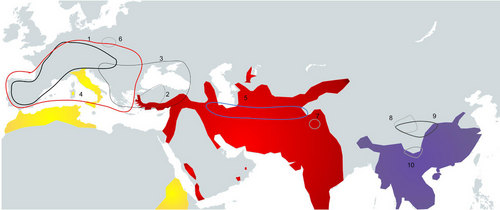
Additional Late Miocene Anatolian Hystrix samples have been collected from various localities, including Çorakyerler, Çobanpinar, Bayırköy, Şerefköy, Gülpınar, and Taşkınpaşa in Türkiye (Fig. 1 and Table 1) (Ünay & Bruijn 1984; Şen 1994; Atalay 1980; Van Weers & Rook 2003; Prieto 2013; Halaçlar et al. 2024).
Taşkinpaşa: An isolated molar sample from Taşkinpaşa exhibits an occlusal pattern and outline noticeably similar to the upper M1 of the Kemiklitepe specimen. However, it is worth noting that the Taşkinpaşa sample is slightly longer and narrower in dimensions when compared to the Kemiklitepe specimen (Şen 1994, fig. I and table 1; Pietro 2013, fig. 1).
Çobanpinar: Van Weers and Rook's (2003) analysis attributes the Çobanpinar specimens to H. depereti based on their EH and larger size. Interestingly the upper dentition of the Kemiklitepe and Çobanpinar samples are closely matched in size and exhibit similar occlusal patterns, with the exception of P4, as highlighted in Şen (1994, table I and fig. 1), and Van Weers and Rook (2003, table 4 and fig. 6B). This suggests that the Perpignan H. depereti differs more significantly from the Kemiklitepe sample than the Çobanpinar sample does. In this context, our preference is to classify it as H. primigenia, although it undeniably warrants further study and examination.
According to the classifications provided by Van Weers and Rook (2003), the specimens from Bayırköy, Şerefköy, and Gülpınar are assigned to H. primigenia. We adhere to their categorization, as it is based on size, EH, and occlusal outline. Additionally, the porcupine specimens from Çorakyerler have been described as a new Hystrix species named H. kayae, with their distinctions from H. primigenia comprehensively elucidated in the study by Halaçlar et al. (2024).
H. primigenia in Eurasia during Late Miocene (in time and space)
Over the past two decades, several comprehensive studies have delved into the Hystrix species of the Late Miocene period in Eurasia and North Africa (Van Weers & Rook 2003; Lopatin et al. 2003; Şen & Purabrishemi 2010; Kovachev 2012; Halaçlar et al. 2024). Van Weers and Rook (2003) examined the dispersal patterns of Hystrix in the Old World, discussing four prominent species: H. parvae, H. aryanensis, H. primigenia, and H. depereti, with a primary aim to reassign some H. primigenia samples to H. depereti. Subsequently, Lopatin et al. (2003) restricted the geographic range of H. depereti to Perpignan, the type locality of H. depereti. Şen and Purabrishemi (2010) made a significant contribution by introducing an additional finding of H. aryanensis, and they concluded that “the spatial distribution of H. primigenia is restricted to southeastern Europe and Asia Minor during the middle-late Turolian.” Kovachev (2012) focused on cranial and postcranial materials of H. primigenia from Hadzhidimovo, Bulgaria, listing H. primigenia localities by country and agreeing with Lopatin et al. (2003) about H. depereti representing only Perpignan.
H. primigenia versus H. depereti
- The EH of H. depereti is higher than Late Miocene porcupines (H. parvae, H. kayae, H. aryanensis, H. primigenia, H. gansuensis, H. lufengensis, H. brevirostra, and H. paukensis) and smaller than that of Plio-Pleistocene porcupines (Wang & Qiu 2002; Van Weers & Rook 2003; Wang & Qi 2005; Şen & Purabrishemi 2010; Nishioka et al. 2011; Wang & Qiu 2020; Halaçlar et al. 2024).
- The last molar of H. depereti is reduced compared to those of H. primigenia, H. kayae, and H. aryanensis.
- There are no significant differences in occlusal outline and pattern between H. primigenia and H. depereti.
Until more detailed comparative studies and additional data become available, the distinction between H. depereti and H. primigenia cannot be drawn with greater clarity.
PALEOGEOGRAPHY OF H. PRIMIGENIA
In this section, we provide information about the presence of H. primigenia in Eurasia by country, and in addition, we include H. depereti localities.
Pakistan
In the Late Miocene of Pakistan, the Hystrix genus is represented by a single species found in the Siwalik, Dhok Pathan Formation—H. sivalensis, Lydekker (1878). Van Weers and Rook (2003) reclassified it as H. primigenia. However, Şen and Purabrishemi (2010) designated it as Hystrix sp., citing the limited available material, consisting of a right mandible fragment with m1 and m2, and nothing that that the hypsodonty of the lower cheek teeth lacks the distinctiveness seen in the upper cheek teeth (Şen & Purabrishemi 2010).
China
Three Hystrix species, namely H. lufengensis, H. gansuensis, and H. brevirostra, are endemic to the Late Miocene of China, as documented by several studies (Wang & Qiu 2002; Van Weers 2004; Wang & Qi 2005; Flynn & Wu 2017; Wang & Qiu 2020). Initially, Van Weers (2004) initially attributed porcupine remains at the Lufengpithecus site to H. primigenia. However, Wang and Qi (2005) established a new species, H. lufengensis, following extensive analysis. H. lufengensis features distinctive characteristics, including squarer cheek teeth, a shorter p4–m3 series, and a less reduced m3 compared to H. primigenia. H. gansuensis differs from H. primigenia with its high-crowned and smaller cheek teeth (Wang & Qiu 2002). On the other hand, H. brevirostra is characterized by higher cheek teeth, a shorter rostrum, a lower horizontal ramus of the mandible, and a shorter and deeper concave mandible diastema compared to H. primigenia (Wang & Qiu 2020).
Russia
Lopatin et al. (2003) reported the first H. primigenia record from the late Turolian (MN13) locality Morskaya 2, Russia. The material, an isolated P4 (TSPI M-2/86-1) (Lopatin et al. 2003, fig. 3), is larger than the Kemiklitepe specimen (KT-1) (Şen 1994, table 1 and fig. 1).
North Macedonia
Spassov et al. (2018) documented four middle-late Turolian localities for H. primigenia in North Macedonia, namely Choloshevski Dol, Kiro Kucuk, Umen Dol, and Vesje. Kiro Kucuk is represented by a mandible, Umen Dol by a maxilla, and Vesje by a partial skull, as outlined by Spassov et al. (2018). The porcupine from Choloshevski Dol was previously reported by Garevski (1956), and a skull fragment with upper molars was described by him.
Spain
According to NOW, Spain has one record of H. primigenia during the Late Miocene in Villastar (Teruel) (Mein et al. 1990). In the Pliocene, there are two records, Layna, Villarroya (Agusti et al. 1987), and Villalba Alta 1 (Adrover 1986).
Alcala and Montoya (1998) initially assigned porcupine materials from Las Casiones to H. primigenia later reclassified by Van Weers and Rook (2003) as H. depereti based on enamel height and size. In this study, we observe a close resemblance in the occlusal outline of the m3 from Las Casiones to those characteristics of H. depereti. Following the methodology and conclusions of Van Weers and Rook (2003), we classify the porcupine materials from Las Casiones as H. depereti. Similarly, the specimens from Villastar have been reexamined and subsequently reclassified as H. depereti by Van Weers and Rook (2003).
Italy
In Late Miocene Italy, three Hystrix records exist: Brisighella (Monticino), Baccinello V3, and Piedmont as documented by Hurzeler and Engesser (1976), Masini and Rook (1993), and Colombero et al. (2015), respectively. Masini and Rook (1993) initially assigned the Brisighella porcupine specimen to H. primigenia but later classified material from Baccinello V3 as Hystrix sp. Subsequently, Van Weers and Rook (2003) reclassified Brisighella porcupine as H. depereti. Colombero et al. (2015) studied the porcupine materials from Verduno, Piedmont (MN13), including an isolated upper molar and a radius fragment, finding the enamel height consistent with H. depereti.
Albania
Festani et al. (1997) studied porcupine materials from the Late Miocene–early Pliocene locality of Shahinova, Albania, assigning them to H. primigenia. This specimen exhibits a reduced m3, with no information on its hypsodonty in the article. Further study may enhance its comparison with H. depereti.
Moldova
The porcupine discovered in the Late Miocene locality of Taraklia (Moldova) was initially described as H. bessarabica by Riabinin (1929) and was later reclassified to H. primigenia by Van Weers and Rook (2003).
France
A reassessment of the Perpignan material led to the determination that the specimens unequivocally pertain to a new Hystrix species, identified as H. depereti (Şen 2001b). Comparative reexamination of tooth size and crown height between Pikermi and Perpignan porcupine highlights that H. depereti surpasses H. primigenia in both size and crown height (Şen 2001b; Van Weers & Rook 2003).
Hungary
The initial report of H. cf. primigenia findings from Polgardi (MN13), Hungary, by Kormos (1911) was later scrutinized by Van Weers and Rook (2003), who concluded that they could not be definitively attributed to any particular species due to the mixed nature of the collection.
Bulgaria
Five H. primigenia findings are reported in Bulgaria: Kalimanci, Strumyani, Hadzhidimovo, Azmaka 6, and Staniantsi (Şen & Korachev 1987; Geraads et al. 2011; Kovachev 2012; Spassov et al. 2012; Bullmann et al. 2013). The Strumyani materials consisting of cranial and postcranial elements were attributed to H. primigenia by Geraads et al. (2011). Kovachev (2012) studied an almost completed H. primigenia skeleton from Hadzhidimovo (MN12), providing a rare opportunity to compare potential postcranial Hystrix findings. Bullmann et al. (2013) reported another H. primigenia finding (p4–m2) from Staniantsi site (MN13–14).
Greece
Recent palaeomagnetic data suggest an age of 7.33–7.29 Ma for Pikermi, the type locality of H. primigenia, that confirms the correlation with the upper part of MN12 (Böhme et al. 2017; Koufos 2023). In the 1960s, two H. primigenia findings from two Turolian Greek localities, Alifakas (7.6–7.1 Ma) and Halmyropotamos (8.9–5.3 Ma) were reported by Melentis and Schneiders (1966) and Melentis (1967). Bonis et al. (1992) identified three H. primigenia specimens from Dytiko-3 (7.1–5.3 Ma), Chomateres (7.6–7.1 Ma), and Halmyropotamos in the Late Miocene Greece as detailed by Koufos et al. (2011). Lazaridis et al. (2018) introduced H. primigenia finding from Kryopigi (8.9–5.3 Ma).
In Samos (7.1–5.3 Ma), Solounias (1981) initially attributed findings to H. primigenia, which include a skull and a mandible fragment with the incisor and a portion of the m3. However, Van Weers and Rook (2003) reassigned it to H. depereti based on characteristics such as high hypsodonty, large-sized cheek teeth, and a reduced last molar. A notable observation is that H. depereti from Perpignan and H. primigenia from Pikermi exhibit square-shaped upper molars (Şen 2001a, fig. 2; Van Weers & Rook 2003, fig. 6). The Samos specimen's occlusal outline is more similar to more rectangular Çorakyerler H. kayae (Halaçlar et al. 2024). A distinguishing feature of H. kayae is the presence of an extra anterolingual groove on P4, while the Samos specimen exhibits DP4. Based on these observations, we propose that the Samos specimen bears a closer resemblance to H. kayae than to either H. depereti or H. primigenia. Thus, we designate the Samos specimen as H. cf. kayae.
Türkiye
In the comparison and discussions part, we provided a detailed analysis of Hystrix findings in Türkiye. In summary, we allocated all Turkish findings to H. primigenia, excluding the Çorakyerler porcupine, rejecting the presence of H. depereti in Türkiye and confining its distribution to Europe and North Africa.
During the Pliocene, H. primigenia and H. depereti are documented across three countries. Fejfar and Sabol (2022) reported H. cf. depereti from the early Pliocene locality Ivanovce (fissure 6513) in Slovakia. In Menacer, Algeria (Africa), Arambourg (1959) initially reported H. primigenia, which was later reassigned to H. depereti by Van Weers and Rook (2003). Georgia's sole H. primigenia records are from Kvabebi (MN16, NOW) (Vekua 1972). In Weze, Poland, fossils initially identified as H. primigenia by Sulimski (1960) were reclassified as H. depereti by Van Weers and Rook (2003). In the most recent study, a new species, H. velunensis, was introduced by Czernielewski (2023).
In Fig. 7, a visual representation unfolds, capturing the dynamic interactions between museum scientists and visitors. This illustrative scene encapsulates the collaborative efforts involved in the detailed process of drawing paleogeographic maps. The focus centers on the utilization of a singular fossil finding, showcasing the intriguing intersection of scientific inquiry and public engagement within the museum setting.
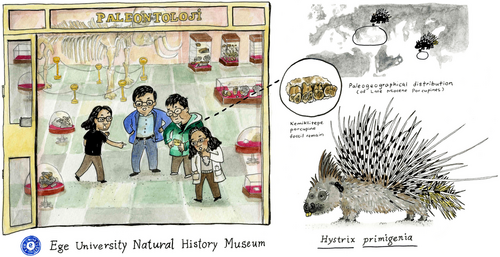
CONCLUSION
This study supports the findings of Şen (1994), who examined an upper cheek tooth series alongside a mandible fragment with a lower incisor and p4. Based on the examination of a hemimandible fragment preserved at EUNHM, the porcupine specimens from Kemiklitepe have been identified as H. primigenia. Our paleobiogeographical analysis reveals that H. depereti was absent in Late Miocene Türkiye, highlighting a broader dispersal range for H. primigenia across Eurasia compared to H. depereti. Notably, both species were not present in Asia, with the exception of Anatolia for H. primigenia, during the Late Miocene. Furthermore, our findings suggest the presence of H. kayae in Samos, Greece, indicating that Greece hosted a third Hystrix species in the Late Miocene.
ACKNOWLEDGMENTS
We would like to express our sincere appreciation to the journal's editor Eric Ameca and reviewers Martin Sabol and Hao-Wen Tong for their constructive comments and feedback on the manuscript. We thank Dr. Danhui Sun for the 3D scan. K.H. was supported through TUBİTAK (The Scientific and Technological Research Council of Türkiye) 2218—National Postdoctoral Research Fellowship Program (Project number: 123C151). T.D. was supported through TUBİTAK (2221—Fellowships for Visiting Scientists and Scientists on Sabbatical Leave). P.R. was supported by the Beijing Natural Science Foundation (International Scientists Project; Funding No. IS23086), and by the Research Fund for International Scientists of the National Natural Science Foundation of China (Grant No. 42350410443).



